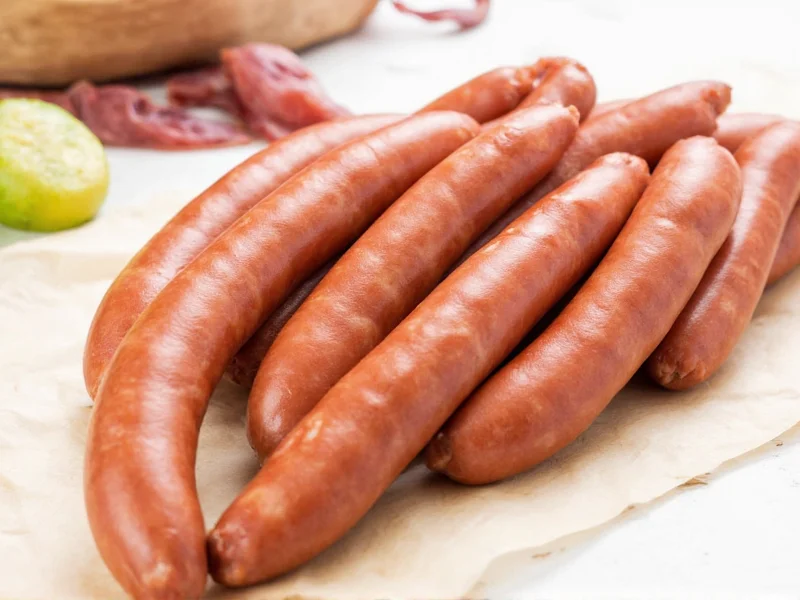When exploring what casings for sausage made of, you'll discover a fascinating world of traditional and modern materials that significantly impact texture, cooking performance, and eating experience. Understanding these options helps both home cooks and professional butchers select the right casing for their specific sausage-making needs.
Natural Casings: The Traditional Choice
Natural casings have been used for centuries and remain popular among artisanal sausage makers. These casings are derived from the submucosa layer of animal intestines, primarily from pigs, sheep, and cattle.
Hog Casings
Hog casings, made from pig intestines, are the most common natural casing for fresh sausages like bratwurst and Italian sausage. They typically measure 32-35mm in diameter and provide that characteristic 'snap' when biting into a sausage. Hog casings are prized for their ability to absorb smoke flavors and their excellent elasticity during the stuffing process.
Sheep Casings
Thinner and more delicate than hog casings, sheep casings (28-32mm diameter) are ideal for smaller sausages like breakfast links and frankfurters. Their delicate texture makes them perfect for sausages that require a finer bite. Many premium hot dogs use sheep casings for their traditional texture and appearance.
Beef Casings
Beef casings come in various forms including middle casings (42-45mm) for large sausages like salami, and beef bungs (70-100mm) for products like mortadella. Beef middles offer exceptional strength for dry-cured sausages that undergo long aging periods. The natural collagen structure of beef casings allows for proper moisture exchange during the curing process.
Synthetic Casings: Modern Alternatives
Synthetic casings provide consistent sizing and specialized properties for commercial sausage production. These materials have revolutionized industrial sausage making while offering solutions for dietary restrictions.
| Casing Type | Material Composition | Common Uses | Edible? |
|---|---|---|---|
| Natural | Animal intestine submucosa | Artisan sausages, fresh links | Yes |
| Collagen | Processed animal collagen | Hot dogs, breakfast sausages | Yes |
| Cellulose | Regenerated cellulose fiber | Smoked sausages, frankfurters | No |
| Fibrous | Cellulose with fibrous reinforcement | Large cooked sausages, salami | No |
| Plastic | Polyamide or polyester | Large cooked products, cheese | No |
Collagen Casings
Collagen casings represent the most popular synthetic option for edible casings. Made from processed animal collagen (usually from牛皮 or pig hides), these casings offer consistent diameter and are available in both edible and non-edible varieties. Edible collagen casings work well for fresh sausages and provide good printing capabilities for branding. They're particularly valuable for manufacturers needing uniform appearance across large production runs.
Cellulose Casings
Cellulose casings, derived from plant fibers, are primarily used for smoked sausages and frankfurters. These casings allow smoke penetration while maintaining structural integrity during cooking. Most cellulose casings are removed after cooking (peelable), though some edible varieties exist. The smooth surface of cellulose casings creates that characteristic uniform appearance found in many commercial hot dogs.
Fibrous Casings
Fibrous casings combine cellulose with paper-like fibers for added strength. These casings are essential for large-diameter cooked sausages like bologna and large salami that require structural support during processing. The fibrous reinforcement allows these casings to withstand the pressure of stuffing large quantities of meat while maintaining shape during cooking. Most fibrous casings are designed to be removed after cooking.
Edible vs. Inedible Casings: What Home Cooks Need to Know
Understanding which casings are meant to be eaten is crucial for both preparation and serving. Natural casings and certain collagen varieties are fully edible and intended to be consumed with the sausage. Cellulose and fibrous casings, however, typically need removal before eating.
When working with unfamiliar casings, check packaging instructions carefully. Some specialty casings like those made from alginate (seaweed extract) offer vegan-friendly edible options, though they're less common in mainstream markets. The growing demand for plant-based sausages has spurred innovation in non-animal casing alternatives.
Choosing the Right Casing for Your Sausage Project
Selecting appropriate sausage casings depends on several factors including sausage type, cooking method, and desired eating experience. For traditional fresh sausages like Italian or bratwurst, natural hog casings provide the authentic texture and 'snap' that many enthusiasts prefer. When making smaller breakfast links, sheep casings deliver that delicate bite characteristic of premium hot dogs.
Home sausage makers should consider their equipment capabilities—natural casings require more skill to handle properly than synthetic options. If you're new to sausage making, starting with pre-flushed, ready-to-use collagen casings can simplify the process while still delivering good results. For smoked sausages, cellulose casings offer excellent smoke absorption and consistent results.
Proper Handling and Preparation Techniques
Regardless of casing type, proper preparation significantly impacts your sausage-making success. Natural casings require thorough flushing to remove salt and any residual matter. Soak them in lukewarm water for 30-60 minutes before use, changing the water several times. Never use hot water, as this can damage the delicate tissue.
Synthetic casings typically come pre-hydrated and ready for immediate use, though manufacturers often recommend a brief water soak to enhance pliability. When stuffing sausages, maintain consistent pressure to avoid air pockets and ensure uniform filling. For natural casings, work carefully to prevent tearing—these materials, while strong, require more delicate handling than synthetic alternatives.
Specialty and Emerging Casing Options
The sausage casing industry continues to innovate with new materials addressing specific dietary needs and production challenges. Edible vegan casings made from plant-based materials like alginate and carrageenan are gaining popularity alongside the growth of plant-based meat alternatives.
Some manufacturers now offer casings with built-in seasoning or flavoring capabilities, while others focus on enhanced oxygen barrier properties for extended shelf life. Research continues into biodegradable and more sustainable casing options that maintain performance while reducing environmental impact.











 浙公网安备
33010002000092号
浙公网安备
33010002000092号 浙B2-20120091-4
浙B2-20120091-4